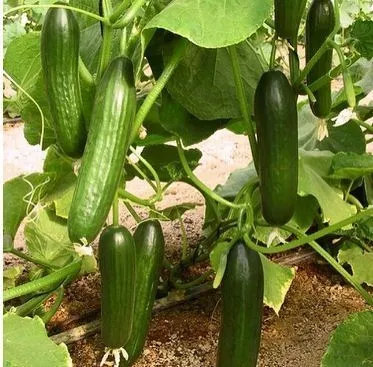Cultivation of Cucumber...!!!
Cucumbers are a versatile and nutritious vegetable that can be easily cultivated and utilized in various ways. Whether enjoyed fresh, pickled, or in skincare products, cucumbers offer numerous benefits for health and well-being.

Cucumbers (Cucumis sativus) are a widely popular vegetable known for their refreshing taste and versatility in culinary applications. They thrive in warm climates and can be grown both in open fields and controlled environments like greenhouses.
Climate and Soil Requirements
-
Climate: Cucumbers flourish in warm and humid conditions, with ideal temperatures ranging from 18°C to 30°C. They need a long growing season with ample sunlight.
-
Soil: They grow best in well-drained, fertile loam or sandy loam soils with a pH level between 6.0 and 6.8. The soil should be rich in organic matter and possess good water-holding capacity.
Land Preparation
-
Tilling: The soil should be deeply tilled and leveled to ensure proper root development. Adding well-decomposed organic matter or compost enhances soil fertility.
-
Bed Preparation: Raised beds or ridges are recommended to improve drainage and minimize the risk of waterlogging.
Sowing
-
Seed Selection: Opt for high-quality seeds with good germination rates. Hybrid varieties are often chosen for their disease resistance and higher yields.
-
Sowing Time: Sowing can be done from February to April for the summer season and from June to August for the monsoon season.
-
Spacing: Seeds should be sown at a depth of 2-3 cm with a spacing of 30-45 cm between plants and 90-120 cm between rows.
Irrigation
-
Watering Frequency: Cucumbers need consistent moisture, especially during the flowering and fruiting stages. Drip irrigation or furrow irrigation systems are ideal for maintaining adequate soil moisture.
-
Avoid Waterlogging: Ensure proper drainage to prevent root rot and other water-related diseases.
Fertilization
-
Organic Manures: Incorporate well-rotted farmyard manure (FYM) or compost into the soil before planting.
-
Chemical Fertilizers: Apply balanced fertilizers such as NPK (Nitrogen, Phosphorus, Potassium) in recommended doses. Foliar sprays of micronutrients can also boost growth and yield.
Pest and Disease Management
-
Common Pests: Cucumber beetles, aphids, and spider mites are common pests. Use organic insecticides, neem oil, or biological control methods to manage infestations.
-
Diseases: Powdery mildew, downy mildew, and bacterial wilt are prevalent diseases. Crop rotation, proper spacing, and fungicidal sprays help prevent and control these diseases.
Harvesting
-
Harvest Time: Cucumbers are typically ready for harvest 50-70 days after sowing. Harvesting should be done when the fruits are young, tender, and uniformly green.
-
Harvesting Technique: Use a sharp knife or scissors to cut the fruit from the vine, leaving a small portion of the stem attached.

Uses of Cucumber
Culinary Uses
-
Salads: Cucumbers are a staple in salads, providing a crisp and refreshing texture. They can be sliced, diced, or julienned.
-
Pickles: Cucumbers are commonly used to make pickles, enjoyed as a condiment or snack.
-
Sandwiches and Wraps: Sliced cucumbers add a fresh crunch to sandwiches, wraps, and burgers.
-
Soups and Gazpachos: Cucumbers can be used to make cold soups like gazpacho, perfect for hot summer days.
-
Smoothies and Juices: Cucumber blends well with other fruits and vegetables to make healthy smoothies and juices.
Nutritional Benefits
-
Hydration: Cucumbers are composed of about 95% water, making them an excellent hydrating snack.
-
Low in Calories: They are low in calories, making them a great choice for weight management.
-
Rich in Nutrients: Cucumbers contain essential vitamins and minerals, including vitamin K, vitamin C, potassium, and magnesium.
-
Antioxidants: They are a good source of antioxidants, which help combat oxidative stress and inflammation.
Health Benefits
-
Skin Care: Cucumbers have a cooling effect and are often used in skincare products to soothe and hydrate the skin. They can help reduce puffiness and dark circles when applied topically.
-
Digestive Health: The fiber content in cucumbers aids in digestion and promotes regular bowel movements.
-
Heart Health: Cucumbers contain potassium, which helps regulate blood pressure and supports heart health.
-
Blood Sugar Control: Some studies suggest that cucumbers may help lower blood sugar levels and support diabetes management.
Other Uses
-
Beauty Treatments: Cucumber slices are commonly used in beauty treatments to refresh and revitalize the skin.
-
Household Cleaning: Cucumber slices can be used to clean tarnished surfaces or remove stubborn stains.
Cucumbers are a versatile and nutritious vegetable that can be easily cultivated and utilized in various ways. Whether enjoyed fresh, pickled, or in skincare products, cucumbers offer numerous benefits for health and well-being.
What's Your Reaction?

















